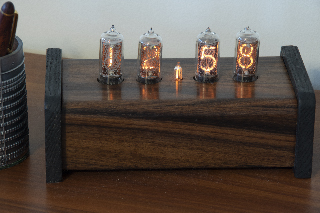 There are zillions of nixie clocks on the web, so I’ll just discuss the atypical features and problems I encountered.
There are zillions of nixie clocks on the web, so I’ll just discuss the atypical features and problems I encountered.
My nixie clock displays time from a GPS receiver (some would argue this isn’t a clock, merely a display). The clock estimates the time zone from the longitude, but since time zone boundaries aren’t straight – they follow political borders – the estimate can be off by ±1 hour if someone lives near the edge of a time zone. So I have a button on the back that cycles through -1, +0, and +1 hours from the estimated time zone. (I realize that some countries have time zones offset by 30 minutes and this clock would not work there.)
For Daylight Saving Time, I put an On-Off-On SPDT toggle switch on the back. In the down position, DST is off; in the up position, DST is on; in the middle position, DST is on automatic and follows the United States DST rules as of 2018.
The nixies are multiplexed, and I regret doing that. I did it to save on PCB real estate and to require only one 74141 BCD-to-Decimal Decoder (little known fact: 74141s are still manufactured by NTE so you don’t have to rely on old Russian equivalents from eBay). The first problem with muxing is that, in a sun-lit room, the nixies aren’t bright enough unless I overdrive them. That’s what I’m doing, but I don’t know how it will affect their life span. If and when I make another nixie clock, I think I will use Microchip’s HV5530 instead of 74141s. It’s a serial-to-parallel shift register with 32 outputs, with open drain outputs that can sink 300 volts.
The second problem with muxing is that it can cause ghosting, where one tube dimly shows its neighbor’s digit. The fault also lies with how I’m driving the nixie anodes. Instead of the common approach with discrete MPSA92 transistors, I used a TLP627, which is a (now discontinued) quad optoisolator. Again, I did it to save real estate. But I provided no way for the 170V to drain away when I turned off the anode. So when I turn off one nixie’s anode, turn on the next one, and select the digit in the 74141, there’s still enough voltage on the first nixie’s anode to dimly display the second nixie’s digit.
The solution I was stuck with was increasing the time between turning one nixie off and the next one on. But this ruined my plan to dim the display when the clock is in a dark room. I can’t (without changing the hardware) speed up how fast the anode voltage decays, so there’s a limit to how much I can dim the display. And it turns out, that limit does not produce a very dim display. So I abandoned the automatic dimming feature and it will have to wait until my next, non-multiplexed clock.
(I have to say, this was an educational experience. I’ve never worked with high voltages before. I naively thought I could turn nixies on and off the way I’ve turned LED displays on and off. Turns out, 170V and just a little capacitance makes things very different.)
I haven’t given up on using ICs for driving the anodes, though. Microchip’s HV513 looks like it can drive 8 nixie anodes. As for getting the nixie’s anode voltage to decay faster, maybe I need a transistor and resistor in parallel with the nixie tube; when I turn the nixie’s anode off, I can switch the parallel transistor on to bleed off the voltage.
Enough about what went wrong. The wood enclosure is made out of Bolivian rosewood, which looks absolutely gorgeous even without any finishing. Still, I put a coat of wax on it. The sides are scraps of red oak that I painted black.
Oh, one last thing went wrong: I made the enclosure too deep (the front-to-back dimension) so that the button and the toggle switch (which are mounted on the PCB) don’t come out the back of the enclosure. I either need to use panel-mounted buttons and switches or get a lot more precise with my mechanical engineering.


Pull-down resistors?
Care to post your schematics?
Was the ghosting problem just that you forgot to include pull-down resistors, or is it more complex that that? How do traditional nixie designs avoid the problem?
I bought a bunch of large nixies (Tesla ZM1042+) on eBay; not sure what to do with the, but they were so beautiful (and seemingly disappearing from the market) that I bought them.
Aren’t you glad that Microchip bought Supertex? Nice parts, but terribly unfriendly people to deal with. If you emailed them they’d ignore you unless you wanted to buy at least $100,000 of one part. They wouldn’t even send datasheets without a NDA!
Microchip opened all that up.
Have tried this when multiplexing just 2 nixies for testing purposes, and it seems to cure ghosting. Use the anode drive of the following nixie (Via series resistor) to drive on another MPSA42 transistor which shunts the previous nixie anode to 0V, thus discharging the residual glow. Be sure to have some blanking time, so as not to have any cross conduction.